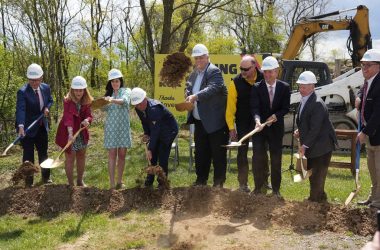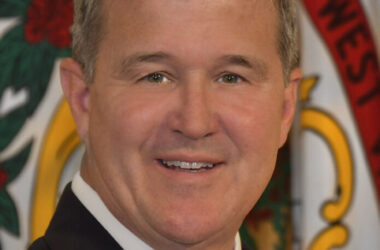CHARLESTON, W.Va. — Work is expected to begin this week on a project designed to stabilize the slip zone at the end of Yeager Airport’s main runway overlooking Keystone Drive and Elk Two-Mile Creek, where landslides on March 12 and 13 destroyed two homes and a church, caused flooding that damaged at least six other homes, and continues to leave five families homeless.
The Charleston airport’s board of directors voted unanimously on Wednesday to award an $855,000 contract to S&E Clearing & Hydroseeding of Varney in Mingo County to remove nearly 150,000 cubic yards of material from the slip zone. In the process of removing the dirt and rocks, the grade of the runway slope facing Keystone Drive would be reduced, enhancing safety from slides.
The contract includes the removal of 36,000 square feet of EMAS, the specially engineered concrete block arresting system designed to bring aircraft to a safe stop in the event of aborted takeoffs or other emergencies, to accommodate the work. That leaves the airport with only about half of its 404-foot-long EMAS safety area.
The airport board awarded the contract on an emergency basis, doing away with the need to follow customary bidding practices.
“We could go through the normal 30-day bidding process, but the material could be down in the creek by then,” Rick Atkinson, the airport’s executive director, told board members prior to the vote.
Atkinson said S&E owner Everett Hannah has agreed to allow the airport to defer payment for his company’s work until after an insurance settlement has been reached between Yeager and the engineers and contractors who designed and built the now-collapsed engineered fill area at the safety overrun area at the end of the runway — a process that could take years.
“If we have another collapse like we had before, I don’t know how we’d get the creek open,” Terry Sayre, an assistant director at the airport, told board members. “We would have to evacuate people again, and we could have a Buffalo Creek-type situation.”
“We don’t have the time or the money and the work needs to be done,”Atkinson said prior to the vote. “Frankly, I don’t think we have a choice” but to enter the contract, he told board members. “The engineers say the material will stay up there for a while, but eventually it’s going to come down. My fear is that if more material comes into the diversion channel in Elk Two-Mile (dug after the March slide), there’s no way to get it open again quickly. …We could have more flooding and water backed up to Go-Mart.”
While the remaining 200 feet of EMAS bed could well be enough to stop an aircraft during an overrun emergency, Atkinson said, the safety feature has been removed from Federal Aviation Administration airport references, meaning pilots won’t take its presence into account in making takeoff and landing calculations until the collapsed portion of the safety zone is rebuilt and the EMAS area is at least partially restored.
Dirt and rocks from the slide area will be deposited in an existing fill zone on the Elk River side of the airport. Removal of the unstable material will begin at runway level, with work taking place after midnight to avoid interfering with commercial flights. Once the removal work moves 40 feet below runway grade, the work can be done during daytime hours.
“Before any rebuilding can be done, this has to be taken down,” Atkinson said of the unstable material in the slip zone.
In another development at Wednesday’s board meeting, Atkinson announced that the airport’s insurance carrier, AIG Aerospace Adjustment Services, has warned the airport authority not to pursue damage settlements with Keystone Drive residents and others if they expect any reimbursement from the insurer.
“AIG’s position is that we have no liability and we haven’t been sued yet, so we shouldn’t have to pay claims,” Atkinson said. “But we have people whose lives are still in limbo 45 days after the slide. We’ve said from the first day after the slide that we wanted adjusters up here to help people get on with their lives, but they haven’t chosen to do so.”
So far, Yeager has settled two claims, one involving a business and one involving the occupant of a mobile home, for a total of about $80,000, he said.
Charleston attorney Matt Nelson, retained by AIG to represent Yeager, told board members that he and lawyers representing the safety overrun area’s designer, Triad Engineering, and contractor, Cast and Baker Construction, have been negotiating for the past 10 days to reach an agreement on how to pay for, and begin processing, claims from those affected by the slide.
“I think we will soon have some form of agreement from which to proceed in resolving claims,” he said.
Meanwhile, five Keystone Drive families whose homes were damaged during the collapse continue to live in hotels, paid for by the airport. So far, the airport has assumed liability for more than $1.2 million to provide emergency shelter and out-of-pocket expenses for evacuees, restore utility rights-of-way, and pay sheriff’s deputies for security services and airport employees for overtime work.
A siren-equipped stream monitoring system in Elk Two-Mile is expected to become operational soon. Meanwhile, the slide site is monitored by video camera by day, and an airport employee by night.
In unrelated airport business, Marketing Director Brian Belcher announced that American Airlines is dropping its Charleston-Dallas nonstop service starting June 12, and adding one daily flight to Philadelphia. Atkinson said there was no shortage of passengers on the Dallas flights.
“The airlines can make more money by having shorter flights, closer to their hubs,” he said.
Reach Rick Steelhammer at [email protected], 304-348-5169 or follow @rsteelhammer on Twitter.




